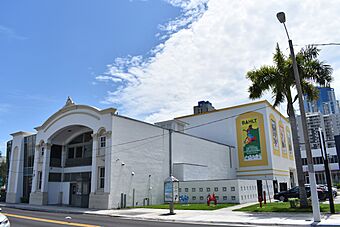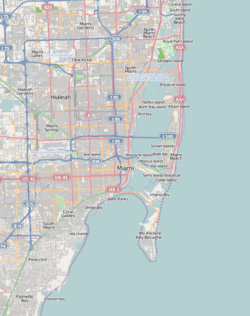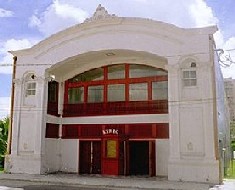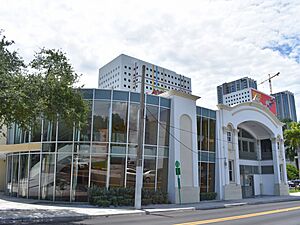Lyric Theater (Miami) facts for kids
 |
|
| Address | 819 NW Second Avenue |
|---|---|
| Location | Miami, Florida |
| Coordinates | 25°46′54.8″N 80°11′52.8″W / 25.781889°N 80.198000°W |
| Public transit | Historic Overtown/Lyric Theatre |
| Owner | The Black Archives History & Research Foundation of South FL, Inc. |
| Capacity | 390 |
| Construction | |
| Opened | 1913 |
| Renovated | 1999, 2005, 2014 |
|
Lyric Theater
|
|
| Architectural style | Vernacular masonry |
| MPS | Downtown Miami MRA |
| NRHP reference No. | 88002965 |
| Added to NRHP | January 4, 1989 |
The Lyric Theater is a historic building in Miami, Florida. It is located at 819 Northwest Second Avenue. This theater was very important to Miami's African American community. On January 4, 1989, it was added to the National Register of Historic Places in the United States. This means it is a special place recognized for its history.
Today, it is called the Black Archives Historic Lyric Theater Cultural Arts Complex (BAHLT). Many people consider it the oldest real theater in Miami. It is a key part of the Historic Overtown Folklife Village. It also helps celebrate black culture and bring new life to the area.
Contents
The Lyric Theater's Story
The Lyric Theater has 400 seats. It was built and owned by Geder Walker. He was a black businessman from Georgia. The theater opened in 1913 in Overtown. This area was once called "Colored Town" and was segregated. The Lyric Theater became a fun place for black people in Miami.
In 1915, The Miami News newspaper wrote about the Lyric. They said it was "possibly the most beautiful and costly playhouse owned by Colored people in all the Southland."
A Hub for Entertainment
The theater was a very important part of "Little Broadway." This area had hotels, restaurants, and nightclubs. It attracted both black and white visitors and people living nearby. The Lyric Theater showed movies and hosted vaudeville shows for almost 50 years. Vaudeville was a type of show with different acts like music, comedy, and dance.
The theater showed the strength of black businesses. It also showed freedom from unfair rules. It helped Overtown feel proud and cultural. This is why Overtown earned the nickname "Harlem of the South."
New Ownership and Community Role
After Geder Walker passed away in 1919, his wife Henrietta took over the Lyric Theater. The Lyric kept working as a theater and concert hall. It was also used as a community meeting place. Schools and local groups held performances there. They also had special events like graduation ceremonies.
Overtown was a popular place for Black Americans to visit. It was even recommended in The Negro Motorist Green Book. Many famous speakers and performers came to the Lyric in the 1940s and 1950s. They attracted many different people, including Black, Latino, and white audiences.
Some famous people who appeared at the Lyric Theater included W.E.B. DuBoise, Mary McLeod Bethune, Marian Anderson, Bessie Smith, Ethel Waters, and the Fisk Jubilee Singers.
Challenges and Rebirth
The Lyric operated as a movie theater until 1959. Then, a church bought it and used it for their services. In the 1960s, governments took over many buildings in Overtown. They built a highway and other "urban renewal" projects. Most of the buildings in "Little Broadway" were torn down.
The Lyric Theater was lucky and was not destroyed. However, it stayed closed for many years. By 1974, it was owned by Bishop Walter McCollough and The United House of Prayer For All People.
In 1988, the Black Archives, History and Research Foundation of South Florida, Inc. bought the Lyric Theater. In 1989, the Theater was listed on the National Register of Historic Places. The building had a lot of damage over the years. It even had a hole in the roof and fire damage inside.
Since 1988, the theater has been restored at least four times. In 2000, after a lot of work, the Lyric Theater opened its doors again. A second phase of work finished in 2004. This included rebuilding the lobby, box office, and offices. Phase 3 involved fixing the stage and other offices. The theater officially reopened in February 2014.
More work happened in 2020 during the COVID-19 pandemic. Termites were found, and the stage was completely rebuilt. The Lyric Theater is now a social center once more. It shows the strength of black businesses and cultural pride.
See also
 In Spanish: Teatro Lyric (Miami) para niños
In Spanish: Teatro Lyric (Miami) para niños







